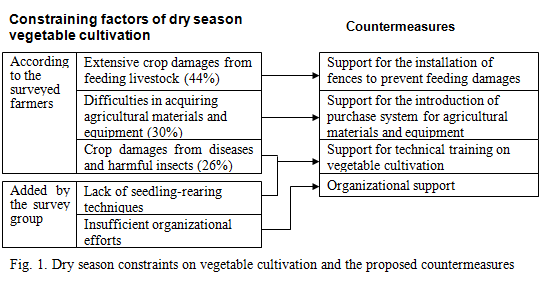Manual for growth promotion of dry season vegetables utilizing limited water resources
Description
The Republic of Niger is situated in an arid to semi-arid area at the southern end of Sahara desert; hence, water is a precious resource. However, these water resources are not fully utilized even though there are a number of seasonal streams and ponds. According to the Water Resources Development Master Plan (1999) report by the Ministry of Water Resources, Environment & Desertification Control, the country has more than 1,000 ponds of which 175 are distributed as permanent ponds. However, these ponds rarely undergo water utilization surveys and there is no clear strategy for its long-term development and use.
As a result, water utilization for dry season vegetable cultivation can be described as underdeveloped even as increased usage is expected in the future. For this reason, the authors recognized the need for the development and diffusion of cultivation methods to effectively promote cultivation of dry season vegetables despite limited water resources.
A questionnaire survey targeting farmers from 37 villages was conducted to identify the constraining factors associated with the growth promotion of dry season vegetables. Three major constraints were discovered from the questionnaire survey, namely: (1) crop damages from feeding livestock, (2) difficulties in acquiring agricultural materials and equipment, and (3) crop damages from diseases and harmful insects. In addition, the survey group also found two more problems from the survey result, specifically: (1) the lack of seedling-rearing techniques, and (2) insufficient organizational efforts. Based on these findings, countermeasures were formulated, including: (1) support for the installation of fences to prevent feeding damages, (2) support for the introduction of purchase system for agricultural materials and equipment, (3) support for technical training on vegetable cultivation, and (4) organizational support (Fig.1). An experimental study of the target sites was subsequently conducted (Fig. 2).
This technical manual summarizes the results of an experimental study performed targeting the periphery of natural ponds which have not been fully utilized. Nevertheless, its contents can be applied not only to natural ponds but also to sites with water sources originating from dams, flood control basins and water wells.
Also, this manual was compiled hoping that it finds a high degree of utilization in the field. The contents were edited with inputs from a technical committee composed of interested departments and agencies of the Ministry of Agriculture in Niger. Concurrently, a repeat peer review in French was also conducted so that local agricultural extension workers can understand and for the manual to gain approval from the Department of Survey and Planning, Ministry of Agriculture.
Lastly, this manual is intended for use by those who provide support and guidance to farmers including extension workers and farmer-trainers employed by non-governmental and international organizations, with the aim of promoting vegetable farming in the dry season. It is necessary to properly implement the contents of this manual to effectively utilize the natural ponds and to promote the growth of dry season vegetables. However, prudence must be exercised when following the instructions contained herein. It must be in accordance with actual site conditions because some of the contents may have already been implemented or the manual may prove insufficient due to reasons that are particularly site-specific.
A total of 500 French-version copies of the manual have been distributed by the Ministry of Agriculture and relevant authorities to field agencies during a publication seminar; thus, providing tangible support to the vegetable cultivation domain and seminar participants.
Figure, table
-
- (left photo) Provision of assistance to organize water resource users. As for the selection of union executives, voting in a secret ballot was adopted so people can select from among multiple candidates and vote anonymously.
- (middle photo) With the farmers' consent and support, fences were installed to prevent crop damages from feeding livestock .Workers learned building fences, from design to construction, via on-the-job trainings.
- (right photo) Implementation of improved farming techniques. Vegetable cultivation training on diversified seedling-rearing techniques, crop disease and pest control measures and water irrigation techniques was provided.
- Affiliation
-
Japan International Research Center for Agricultural Sciences Rural Development Division
- Classification
-
Technical
- Research project
- Program name
- Term of research
-
FY 2011 (FY 2007~FY 2011)
- Responsible researcher
-
Osuga Kimio ( Rural Development Division )
Dan Haruyuki ( Rural Development Division )
MIERUKA ID: 001800Yasuhisa Johtaro ( Rural Development Division )
Shinohara Togo ( Rural Development Division )
Charles Marie-Line ( Rural Development Division )
Kawano Naoyoshi ( Rural Development Division )
Omae Hide ( Tropical Agriculture Research Front )
MIERUKA ID: 001794 - ほか
- Publication, etc.
-
Manuel pour la promotion du maraîchage en saison sèche en utilisant les ressources en eau des mares naturelles, (2011.10.1) https://www.jircas.go.jp/ja/publication/manual_gudeline/1
- Japanese PDF
-
2011_01_A4_ja.pdf94.75 KB
- English PDF
-
2011_01_A4_en.pdf265.14 KB


